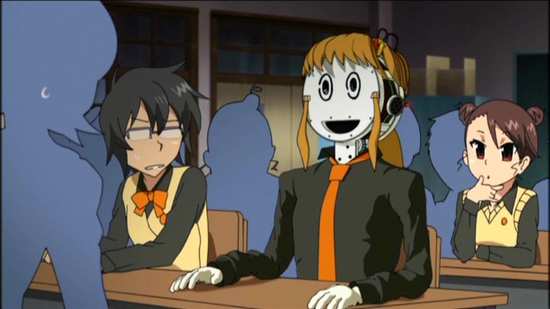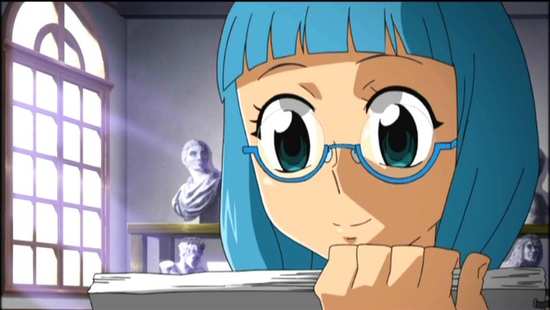Review for Hyakko: Complete TV Series
Introduction
It isn’t every day that I buy the first three titles from a new anime label, sight unseen, but that is what happened with Lucky Penny’s initial batch of releases. Of course that sentence isn’t strictly true, as Lucky Penny is Nozomi Entertainment’s budget label, releasing no-frills discs for titles that don’t warrant the usual Nozomi luxury treatment. Under the RightStuf aegis, Lucky Penny has a lot of pedigree when it comes to getting its anime releases right. At the same time, I have watched their first three titles on Crunchyroll and know full well what to expect. The reason that I pounced on them in the first place is that I knew just how special and unique they are, or at least two of them...
Ristorante Paradiso was a romantic show set in an Italian restaurant in Rome, based on a manga that targeted the older female demographic, with sort of a reverse harem of older, elegant and refined men. Sweet Blue Flowers was a gentle tale of first love between high school girls, with an eye on realism of emotion and character. These two shows aren’t the sort of anime that the mainstream distributors focus on. This third Lucky Penny title on the other hand, Hyakko, is as mainstream as it gets, as it’s a high school slice of life comedy.
They say that the friends that we make on the first day of school will become our lifelong friends. For good or ill, that happens for four girls at their first day together in high school in Kaminozo Academy. Kaminozo Academy is less a school than it is a small city, its vast campus encompasses education from elementary school to high school, and it nurtures 3000 students. It’s easy to get lost going from class to class, and that is what happens on Ayumi Nonomura’s first day, as she winds up wandering the quadrangle looking for her next class.
You might think it’s a stroke of good fortune when she bumps into classmate Tatsuki Iizuka, as she’s a veteran at Kaminozo, having been attending since elementary school. But it’s still a big school and even she’s lost, although the tall, elegant and aloof Tatsuki would be the last to admit it. After some more aimless searching, a second storey window opens, and an orange-haired girl gracefully leaps out. Torako Kageyama has a straightforward approach to school navigation, take it as the crow flies. She knows which building her next class is in and she’s going straight there. Hot on her heels is her best friend Suzume Saotome, who insists on making pit stops for food. The four hook up for an adventure on their first day, getting to their next class no matter what it takes, and no matter who they have to go through. Such shared adversity will forge the bonds of friendship, whether they want them or not.
Thirteen episodes are split across three discs.
Disc 1
1. Meeting Torako
2. You Can’t Catch a Tiger Cub Without Going into the Tiger’s Den
3. A Tiger at the Front Gate, Another Tiger at the School Gate / Paper Tiger
4. Drink Like a Cow, Eat Like a Horse and Tiger / A Tiger is Best in the Company of Another Tiger
Disc 2
5. An Uncanny Relations Formed By A Tiger / Stay With a Person to Learn About the Person, Fight With a Tiger to Learn About the Tiger
6. A Tiger That’s Kind to its Neighbours
7. When the Fox and the Tiger Meet, It Spells Doom / A Fox Borrows the Tiger’s Might
8. An Arrow Stuck in a Tiger / I Drew a Tiger, But it Ended Up a Pussycat
Disc 3
9. Kindness is Not Done for the Tiger’s Sake / Suzume It Will Be Given to You
10. Wings on a Tiger
11. Escape from the Tiger’s Jaw
12. First a Princess, Then a Son, Then Torako / A Demon’s Concern for Torako
13. Four People Can Create a Tiger
Picture
Hyakko gets a 1.78:1 anamorphic widescreen transfer on these NTSC discs. The image is clear and sharp throughout, with strong, bold colours. It looks to be an interlaced transfer, generally smooth, but with slightly uneven pans and scrolls, and a bit of ghosting and blended frames.
Hyakko is a gag anime, and doesn’t really receive the big budget animation of other shows. The character designs are memorable, and are very well accomplished, but the animation can be limited at times, and there are moments that you sense care slipping, as well as the budget. I remember that there was mention of the animation being revised between broadcast and home video release, as so often happens with broadcast anime, but some flaws crept through the gap, and one noticeable instance in episode one is Ayumi’s mouth wandering around her face as she speaks. But by and large the animation does improve as the series progresses, and never fails to get the story across.
Sound
Hyakko is a subtitle only release, and the sole audio track is a DD 2.0 Stereo Japanese one. The sound comes across without issue, no glitches or drop-outs, while the subtitles are accurately timed and free of error. As mentioned, this is a gag anime so it’s not an exemplar of sound design. The dialogue is clear though, and what action there is does get a bit of stereo placement to it. Hyakko makes use of classical music in some of its scenes, and the effect really works well to emphasis the comedy. While I love the opening theme song, the end theme isn’t my favourite. While you’d expect shows like this, which skirt the mainstream to be shoe-ins for dubbing, it’s initially surprising to see that this one is subtitle only. It’s only when you look at the Liner Notes on each disc, and realise just how much of the dialogue is wordplay and punnage, then you can understand the reluctance to translate it.
Extras
Again the lower budget of Lucky Penny means the discs are presented in a no-frills manner, in an Amaray sized litebox, with one disc on one pane, and two overlapping at the rear, and none of the discs all that easy to access.
Each disc boots up with a trailer for Rightstuf.com, and ends with a translated English language credit scroll for all episodes held within. They present their contents with static menus.
Disc 1
Here you’ll find the textless credits sequences. You’ll also find 21 pages of translation notes for the show that provide cultural context for some of the jokes. It’s a very useful addition and well worth going through.
Disc 2
Here you’ll find the broadcast textless credit sequences (an OP with clips from EP 1, and an ED full of concept art), and 15 more pages of liner notes.
Disc 3
This disc contains five episodes, and that means 26 pages of liner notes, the most of all three discs. You’ll also find the U.S. Trailer for the show.
Across all three discs, you’ll find trailers for other Nozomi and Lucky Penny titles, such as Ristorante Paradiso, Maria Watches Over Us Season 1, Sweet Blue Flowers, Antique Bakery, Emma Season 1, Revolutionary Girl Utena: Student Council Saga, Gravitation TV, Junjo Romantica Season 1, and Sound of the Sky.
A short Hyakko OVA about Torako and Touma eating cake was made, but isn’t present on this release.
Conclusion
I love Hyakko! The high school comedy is an oversubscribed genre, and it’s very easy to churn out an identikit anime that blends in with all of the rest. In my opinion, the pinnacle was reached early on with Azumanga Daioh, and all the other shows have been playing catch-up ever since. That isn’t to say that there aren’t shows worth watching out there, there certainly are, but when it comes down to it, you usually wind up comparing them, and comparing them unfavourably. You have to look for something unique, something that makes them stand out, whether it’s in their premise, their characters, or just the execution.
As you would expect, Hyakko is no Azumanga Daioh, but it ticks the most important box when it comes to anime comedy; it makes me laugh. Better than that, it forces me to laugh, not the knowing chuckle or wry giggle for this show, it elicits full-on belly laughs at the ridiculous situations that develop. When the first episode, with its character trek/bonding across the school campus, ends with the main character punching a teacher in the stomach in the hope that he’ll forget he ever saw her, you know that this show will be going for the comedy jugular, and it usually succeeds across its thirteen episode run.
One big difference between Hyakko and its peers is that it isn’t based on a four-panel gag manga. Those quick-fire set-up punchline formats can result in hilarious shows, such as Azumanga, and through careful writing can allow for character development as well. But often they result in rather hit and miss shows, with some gags working and others misfiring. Hyakko on the other hand is adapted from a longer form manga, which allows for greater story and character development. True, these are shorter form stories, with most of the episodes in the series split into two parts, but what stands out most prominently is this show’s character focus.
The show begins by introducing the four main characters, with Ayumi the typical shy but cute girl, running into the typical tall but aloof girl Tatsuki, as they try and find their way around the campus. Everything goes up a gear when they encounter Torako as she leaps from a second floor window. Torako is a veritable force of nature, a whirlwind of boundless optimism and idiotic self-confidence. Once she decides to be your friend, there’s absolutely nothing that you can do about it. It’s inevitable. She’s the kind of character that sucks everyone into her schemes and can be found at the centre of every commotion. Her best friend is Suzume, and she’s the oddball character, the one with a quirky outlook on life, and a boundless appetite. There’s always one schoolkid who can leave everyone else gaping at the black hole where their stomach used to be. I know, I used to be one. Unfortunately that kind of behaviour catches up on you after your final growth spurt if you aren’t careful.
The first couple of episodes are devoted to establishing the character dynamic between the four, with Tatsuki trying, and failing not to be friends with Torako, during a day trying to find which afterschool club to join. After this, the show starts to introduce the other oddball characters in the class, with stories devoted to exploring them. The class president Nene turns out to be something of a predatory pervert (something of an anime cliché with all the nosebleeds), Chie likes making robots in her club, which gives Torako an idea for skipping class, Koma is a member of the photography club, and soon becomes an assistant for an upperclassman who makes a profit on photos of the first year girls, Ushio’s the loner delinquent with a hidden softer side as Torako discovers, Inori’s the girl in class who creeps everyone out due to her resemblance to Sadako, but really just wants to make friends, Minato is the kind of clingy friend that you’d just like some distance from, but doing so would be like kicking a puppy, and Touma is the one girl who remains immune to Torako’s hand of friendship.
As the cast expands, so does the comedy, and the show gets better the further in that you go. It still manages to hold onto that gag manga feel, even though the stories are long enough to develop the characters. One or two gags do miss the target though, with the end of episode six offering a trailer for a non-existent Hyakko action movie that leads into the second half of the series. There’s also a Suzume = human dustbin joke that overstays its welcome. Otherwise this is consistently funny stuff.
That’s until the final two episodes, where the comedy takes a back seat to the character drama. The show’s emphasis on character development has a point, and that is to get underneath the surface of Torako’s insane optimism. There’s a reason why she is so cheerful, and that’s because she’s running from something. We get an inkling of that when her older brother Kitsune is introduced, and turns out to be something of a sly bully. The penultimate episode also expands on the character of Oniyuri, Torako’s older sister, and we get to see Torako’s vulnerable side, and her uncomfortable home life, and we also get to see what making all these new friends in high school actually means to her.
That’s reiterated in the final episode, which takes us right back to the beginning, and we see just what Torako was like before she started high school. These two episodes really rein back on the comedy, but they do put the show in context, and really give the story some heart. As a comedy, it is a bit of a disappointment to end the show on a more serious note, but otherwise Hyakko is a really fun character comedy with just one or two minor missteps. I would suggest that if you’re interested, you just import it, as the likelihood of it getting the usual US-AU-UK dance of licensing is unlikely after all this time. Stranger things have happened though.
















































































Your Opinions and Comments
Be the first to post a comment!